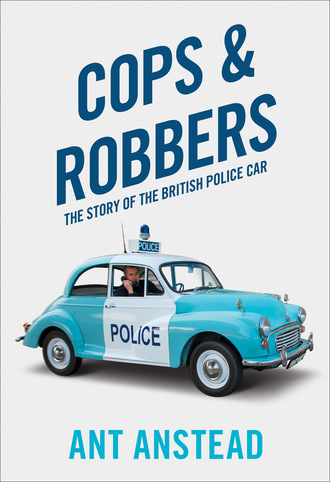
Полная версия
Cops and Robbers
However, in 1975, when Rover replaced the P6 with the all-new SD1 3500 V8, the Met’s area car crews were all reduced to the 2.6-litre model. Out went the spot lamps and blue paint, in came white cars with orange and gold stripes along the sides and little else to distinguish them from Traffic cars save the single blue light instead of twin beacons. Both the P6 and SD1 served the Met brilliantly over a period of 15 years, and that aforementioned cult status isn’t a label applied lightly – although elsewhere in chapter eleven you can read more details about the SD1 and why the choice of the 2.6-litre, 6-cylinder over the 3.5-litre V8 made by accountants backfired spectacularly.
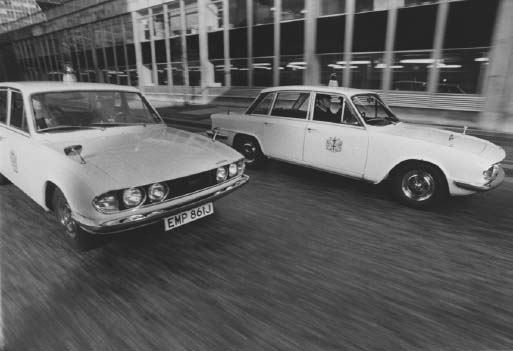
City of London Police Triumph 2500 Pis at speed.
Rover’s biggest challenge came from Triumph, when it launched the 2000 range at about the same time that Rover introduced the P6 in 1963. Another big four-door saloon with a decent engine, it was seen by many forces as a Traffic car rather than an area car, and in later Mk2 Pi trim, even more so. However, some forces did utilise the Mk1 Triumph 2000 as an area car, including the Stoke-on-Trent City Police, Somerset and Bath Constabulary and the Nottingham City Police, who had their cars finished in black with the city coat of arms placed on the front doors. The Met Police used the Mk2 2500 TC as area cars about the same time as the Rover P6 models. They were painted in either Delft blue or Pageant blue and were said to be lighter and easier to drive than the Rover but did suffer from engine overheating when in heavy traffic and from a number of other niggling faults. The City of London Police used the Mk2 saloon as area cars, all of them finished in white to differentiate their cars from neighbouring Met vehicles.
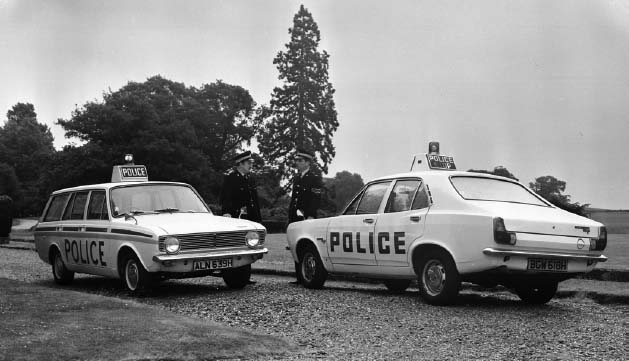
A Rootes Group publicity image from 1970, taken to publicise their range of special police vehicles.
The Rootes Group, usually using their Hillman badge on smaller cars and Humber on larger cars, produced some ideal cars to fulfil the role, especially with its Hunter and Minx saloons. For a decade from 1966, the company produced this solid four-door saloon with a 1725cc motor capable of achieving 95mph. It had dependable handling and was a tough and solid car. It was everything an area car should be, and those officers who once crewed them remember them with a fondness not afforded to other cars. Many forces utilised the Hunter and its round-headlight twin the Minx, including the Sheffield and Rotherham Constabulary, Durham, Hampshire, Surrey, the British Transport Police and the Ministry of Defence Police. Developed under the internal code ‘Arrow’, the Hunter range is often forgotten now but it achieved an enormous amount in its quiet understated way, not just with the police. Not only did Andrew Cowan, Colin Malkin and Brian Coyle win the 1968 London–Sydney Marathon in one, but it also remained in production, latterly only as a pick-up, until 2015 in Iran where it was known as the Paykan, which is, apparently, Persian for Arrow.
The later Hillman Avenger was even more popular with forces such as the Avon and Somerset, West Yorkshire, Sussex, Dorset and Kent Police. Although it had a slightly smaller engine, at 1598cc, it was almost as quick as the Hunter/Minx and, being the younger of the two models, was obviously a more modern drive. Its styling wasn’t to everyone’s liking, though, due to its rather heavy-looking rear end. Sussex Police in particular bought lots of them and they remained the area car in that county for many years.
Volvo. Yes, Volvo. Many years before those legendary figures ‘T5’ hit the automotive headlines, Volvo had enjoyed a modicum of success with a few forces but none more so than in Hampshire, who had pioneered the Swedish brand in 1965 when it bought the 121 Amazon estates as Traffic cars, followed by the 144DL in 1968, again for traffic patrol, until about 1973 when the car got downgraded to area car role because more powerful cars like the Rover 3500 V8 and Mk2 Triumph 2500 Pi were now the favoured tools. But the force stayed loyal to the Volvo 144DL, which was followed in 1975 by the new 244DL with its 2.1-litre engine. Every station in the county had one as their area car, although a number of other cars like the Hillman Hunter, the Mk3 and Ford Cortinas were brought in, but in very small numbers along the way. Forget all the very unfair journalistic ‘tank’ labels given to it over the years, the Volvo was a big, solid, dependable car that was perfectly suited to the role. In 1979 Volvo upgraded the engine to a 2.3 litre, added fuel injection, a 5-speed gearbox, alloy wheels and a few other bits, and all of a sudden the ‘tank’ would top 115mph with a 0–60 time of just nine seconds. Those stats are identical to those of the Mk2 Ford Escort RS2000 that those same journalists all raved about! In 1985 Volvo introduced the 240 Police Special, built to Swedish Polis specification. It got the same 2.3i engine and performance figures, but Volvo built the car with frontline police work very much in mind, with steel wheels instead of alloys, half-cloth and half-vinyl front seats, all-vinyl rear seats to facilitate the mopping up of blood and vomit, no rear window winders and a rubber compound on the floor instead of carpet. The first 244s were released in 1975 and the last 240 version in 1990 – during which time the Hampshire Constabulary bought no fewer than 276 of them, all for area car use. There can be few other cars that have spanned 15 years and managed to outgun all the new arrivals, staying the course until it was no longer available. There were many police officers who genuinely mourned its passing – and you can’t say that about many cars. Certain officers who were unfortunate enough to be driven into by other road users also credit the Volvo with saving their lives, at a time when few other manufacturers were prioritising occupant safety in accidents.
One of Hamphsire’s 1985 Volvo 240PS area cars, photographed at Brooklands’ annual Emergency Services Day (which is well worth attending, by the way). It’s been restored by ex-Hampshire officer Steve Woodward and is the only one preserved in police livery of the 276 244/240 models the force used. The light bar really was a roof-rack-type bar with two lights on, as this image clearly shows!

They were fitted with a switch panel for the police accessories which became almost legendary within the force, because the switches had a particularly tactile, satisfying action. And, okay, I’m admitting it here, I love a good switch action, so I totally get why the purple switches were so loved.
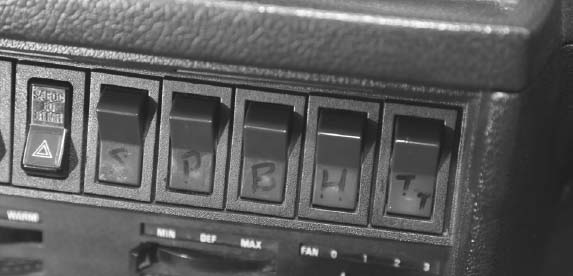
Left to right
S - Stop box on boot flashing stop
P - Police sign
B - Blue lights
H - Headlamp flasher
TT - Two-tone horns
In 1995 BMW entered the medium-sector police market like a bull in a china shop by giving us the 325 TDS. What? Diesel-powered patrol cars? Diesel? Really? No, this must be some kind of a wind-up, surely? Diesel is for tractors and buses! Coppers all over the country were now looking for the culprit who started this vicious rumour. But it wasn’t a rumour; in fact, far from it. BMW had refined the diesel unit to such an extent that it gave the car a huge amount of useable, low-down torque, which was delivered in a very smooth manner without the clanking sounds of previous diesel-powered cars. It was an ideal power plant for area car use, with the added bonus of better fuel consumption and higher mileage possibilities before resale. And, of course, BMW had built its previous reputation on being a driver’s car, so within seconds every copper had a smile on their face once more. Without a shadow of doubt the BMW 325 TDS was a huge success story, not just for BMW themselves but for the police service as a whole. The car had very few vices; it was fast, comfortable, handled well and had that all-important ingredient: presence. It looked the part. Forces all over the UK took them on, and over the next few years and into the twenty-first century the 3 Series has continued to dominate the area car sector because quite simply it’s almost the perfect package.
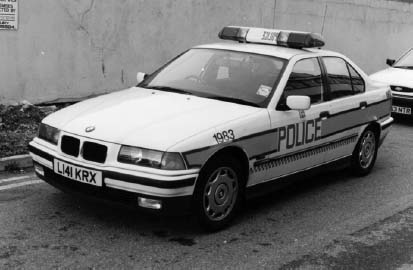
Volvo story
The early Volvo 244 GLT cars were actually used as Traffic cars for a while alongside BMW 525 saloons. The Volvos were fitted with very nice-looking five-spoke alloy wheels; a first in its class. A traffic unit driving a Volvo 244 GLT picked up a Triumph Trident motorcycle one night that was suspected of doing a big drugs run into the city; the bike failed to stop and a very high-speed pursuit started, with the bike reaching speeds in excess of 100mph. The bike entered the city but its speed rarely dropped below 60mph. A second Volvo area car now joined the chase and positioned itself behind the Traffic car. As they sped towards a large crossroads the Triumph didn’t slow down at all and went straight across it at 60-plus mph. The traffic Volvo hit the brakes hard and the rear nearside of the car slewed to the left. A huge arc of sparks, some 20 feet high, was seen coming from the rear before the car travelled across the same crossroads. Less than two miles later the biker fell off his machine and was arrested. A two-pound bag of heroin was found under the seat. After everything had calmed down a bit, one of the officers present called the traffic officers over to look at their car. We all stood in disbelief as we looked at the rear nearside alloy wheel, which now only had one of its five spokes left! A shudder went down the spine of the driver when he realised that after hitting that kerb he was still driving the Volvo at over 80mph.
Police Constable Gledhill GC
On the night of 25 August 1966, Police Constable Gledhill and his colleague PC McFall were on patrol in ‘Papa 1’, a Metropolitan Police area car, when they got involved in a high-speed chase with heavily armed robbers who fired fifteen shots at them during the pursuit.
For his bravery that day Tony Gledhill was awarded the George Cross; the highest civil award this country can bestow.
The citation for Constable (later Detective Sergeant) Gledhill’s George Cross was published in The London Gazette (dated 19 May 1967), as follows:
Constable Gledhill was driving a Wolseley 6/110 police vehicle with wireless operator Constable McFall, when a message was received stating that the occupants of a motor car had been seen acting suspiciously at Creek Side, Deptford. As the officers reached the area they were looking for, a car (also a Wolseley 6/110) containing five men drove past them.
The officers immediately gave chase to the suspect vehicle which was being driven recklessly through the streets of South London, travelling on the wrong side of the road and against the one-way traffic system. In such conditions Constable Gledhill exercised considerable skill in following, at high speed, and in keeping up with, the vehicle.
During the chase, which covered a distance of 5 miles at speeds of up to 80mph, an attempt was made to ambush the police vehicle and no fewer than 15 shots were fired at it by the occupants of the suspect car, using a sawn-off shotgun and revolvers. Pellets from the shotgun struck the windscreen of the police car on three occasions.
Finally, at a road junction, the escaping car crashed into a lorry. The five men immediately left their vehicle and a group of three ran into the yard of a transport contractor.
The officers followed the group of three and as the police car reached the yard gates the men ran towards it; one of them was holding a pistol. He then proceeded to hold it to Constable Gledhill’s head. He ordered the officers to get out of the car or be shot. Both officers left the car and the man with the pistol got into the driving seat with the obvious intention of using it to make a getaway.
Constable Gledhill, then backing away across the roadway, was targeted again as the man reversed away from the gates towards him, pointing the pistol at him as he did so.
However, when he stopped to engage first gear he momentarily turned his head away and Gledhill immediately grabbed hold of his gun hand. As the vehicle moved off, Gledhill managed to hold on to the car window with his left hand.
While this was happening, Constable McFall had run along the roadway to a group of men in order to get a lorry driven across it in the hope of blocking the hijacked police car, when he heard Constable Gledhill shout.
He ran back to the police car and saw him holding on to its window. He then saw the vehicle gather speed, dragging Gledhill along the road. At this point the front offside tyre burst, the car veered across the road, crashed into parked vehicles and Gledhill was thrown under one of them. McFall opened the front passenger door and as the driver was still holding the pistol, began hitting him about the legs and body with his truncheon.
Gledhill had then regained his feet and as he approached the driver’s door it was flung open, knocking him to the ground.
The man got out of the car and backed away from the officers. He warned them not to move and at the same time fired a shot. The Constables then heard the gun click and both rushed at the man, and as McFall struck at him with his truncheon Gledhill grabbed the man’s right hand and took the gun from him. There was a violent struggle and the gunman fell to the ground, trying desperately to reach the inside of his jacket.
At this stage other officers arrived. The man was subdued and another gun, an automatic pistol, was found in the pocket of his overalls.
Both Gledhill and McFall received injuries and had to receive hospital treatment. They had faced a sustained firearm attack and from the early stages knew the risks they ran of being killed or seriously injured.
For his conduct, Constable McFall was awarded the George Medal.
During an interview in late 2010, Gledhill was asked how accurate the citation was, to which he replied, ‘It’s actually a pretty good description of what happened’. On being asked why he and PC McFall got called to the scene, he answered, ‘It was the school holidays and a school caretaker’s son happened to look out of a window and saw five men putting on masks and dungarees and getting into a car. He told his dad and his dad called the police.’
Gledhill was asked what kind of car the robbers had. ‘Actually, they had a car just like ours – another Wolseley – but in a two-tone blue colour. The only difference was, theirs was manual’. This actually makes the chase even more impressive, an automatic Wolseley, on cross-ply tyres, chasing a manual version, at speeds of up to 80mph, in the wet!
Of the chase he said, ‘Once or twice I thought I would lose it. Not long after the start of the chase it started to go and I said, “I’m going to lose it”. Terry, my wireless operator, replied, “You won’t, you won’t, you won’t.” And I didn’t!’
Tony explained what Wolseleys were like as police cars: ‘I used to really like them. They were not too bad at all. When I first passed my police driving course at Hendon, in 1963, I was based at Lee Green Police Station driving Wolseley 6/90s. They were much heavier. The 6/110s were nicer to drive, although around South London you could rarely get any speed up (but you could really get your foot down on the Sidcup Bypass!). I enjoyed getting up a good speed in them.’
By the time of the incident Tony was based at Lewisham Police Station.
‘We had two Wolseleys at our station and there were three shifts. The cars were always used alternately unless there was a breakdown.’ On being asked if he drove the Wolseleys all the time, he answered, ‘No, as a policeman in those days you might find yourself on the beat for six or nine weeks, or as a police van driver on van duty, or driving the area cars (the Wolseleys).’
He was asked whether he was involved in the maintenance of them. ‘No, but we were lucky as the Traffic Division workshops were on site at Lewisham so we didn’t have to take them anywhere. The area car I was driving on the day was my favourite. Its call sign was “Papa 1” (registered CYK 360C).’
Tony was asked the question that is always asked of people who have done incredibly brave acts in the face of death or serious injury, ‘What made you do it?’ His answer? ‘I have no idea.’
Burned-out Senator story
There’s nothing an area car driver likes more than to borrow a Traffic car if theirs is in the workshops for some reason. And there’s nothing a traffic cop hates more than having to lend one of ‘their’ cars out to a lowly area car driver, especially if they return it dirty or with no fuel in it.
Within my office, despite our best efforts to deny our area car colleagues the loan of our cars, we were told in no uncertain terms by the white shirts that the cars were in fact a force resource and not our own personal transport. So it was one wet wintry evening that the phone rang. It was the area car crew from Havant nick with the question that I didn’t really want to answer: Could they borrow a car for the night shift as theirs was off the road? We ran a 50/50 fleet of BMW 525i saloons and Mk2 Vauxhall Senator 3.0i 24-valve cars at the time and I told them to take the oldest car on the fleet; a K-reg Senator. After giving them the usual lecture about fuel and washing it down before returning it, I went home.
The next morning as I sat in the kitchen eating my breakfast, I switched on the local radio station to listen to the news. It was the main headline, ‘Police car explodes into flames in Havant after crashing into a gas main but thankfully with no injuries!’ A wry smile came over my face but it was immediately wiped off when a local resident was interviewed and stated that it was ‘one of them motorway cars’.
It transpired that the area car crew were on a shout, in the wet, and as they negotiated a right-hand bend they lost it, over-corrected it, entered the forecourt of a local house and collided with a cast-iron box about two feet square that contained the mains gas pipe to the house. The Senator landed on top of the box and as the escaping gas met the exhaust manifold … boom, up it went. That same local resident went on to say that the 20-foot-high flame coming through the bonnet resembled one of those Bunsen burners we used at school! Needless to say, we didn’t get the Senator back and the area car crew never asked us for another one!

CHAPTER SIX
PANDA CARS
‘Panda Car; noun (plural, panda cars), a police patrol car; originally white with black stripes on the doors.’
Oxford Concise Dictionary
It’s not every day you discover that one of Britain’s best-loved institutions is wrong! But then it is somewhat of a surprise that the term is in the Oxford Dictionary at all. What is annoying but not a complete surprise is that their definition is wrong, because it states that the cars were white with black stripes on the doors. Over the years, the public’s perception of what constitutes a ‘panda car’ has become blurred, so maybe now is the time to put to bed a few misconceptions, blow away a couple of myths and establish once and for all that not all police cars are in fact pandas.
So, let’s go back to the Oxford definition. Where did the name ‘panda’ originate? And why has the term continued to be used into the twenty-first century when the last real panda cars became extinct way back in the early 1980s?
Mid-1960s Britain was facing a bit of a police recruiting crisis; there simply weren’t enough officers to go around (nothing new there, then!), particularly on the big new housing estates that were being built all over post-war Britain. It must be remembered that most policemen during this period walked the beat or rode a bicycle and police cars were few and far between. Sure, every force had a Traffic Division, whose responsibilities consisted of attending road traffic accidents, escorting abnormal loads and, in one or two counties, policing the new motorways. Traffic didn’t attend such routine calls as domestic disputes, pub fights or kids kicking footballs against people’s windows.
Most stations would have had access to a van to transport prisoners, and there might have been an unmarked car that could be used by a supervisory officer of at least Sergeant in rank, to check up on the foot patrols at various ‘points’ throughout the day. As a member of the public requiring police attendance you could wait quite a long time for an officer to plod his way across his beat to get to you, and it has to be said that the beat bobby could be virtually invisible to the public, especially at night. The modern-day notion that in the ‘good old days’ there were 6-foot 5-inch coppers everywhere you looked, clipping young scrumpers around the ears, is little more than an urban legend, a myth that has been told over and over again and even appeared in Just William and other fiction. If your beat was just one mile square it would take you all day to patrol every street just once, therefore these legends of law enforcement were certainly not seen on every street corner, outside every school or lurking behind the walls of every orchard.
And therein lay the problem. There just weren’t enough coppers to go around. And society in general was moving faster as cars became more accessible to the general public and reliable, too. The solution to this dilemma was brilliant, Unit Beat Policing, or UBP, changed the face of policing in Britain. In 1964 the Chief Constable of the Lancashire County Constabulary, Colonel Eric St Johnson, who was a frequent visitor to the USA, had noticed that in many cities their patrol cars were black with white doors and had the word ‘police’ on them, surmounted by the town’s coat of arms. This made them stand out from the usual plain cars used by the public so that they were easily identifiable as police cars. He brought the idea home and had a couple of Mk3 Ford Zephyr 4s, which until now had been unmarked crime cars, dragged into the police workshops where they were resprayed into the blue and white colour scheme. Colonel St Johnson liked the idea that light blue be the chosen colour because he was a Cambridge University man! He worked with William ‘Palf’ Palfrey, the Chief Superintendent of Accrington, a division within the Lancashire County Constabulary that developed theories on how policing would change post war to cope with the needs of changing work patterns, mobility and mechanisation. Experiments with detailed versions of the basic idea were carried out in both Kirkby and Accrington; the Accrington idea being foot patrols backed up by teams of mobile detectives rather than bobbies moving between ‘beats’.



